Classic Nikon SLR Cameras
Click towards the left edge of the thumbnails to see a normal
B&W photo, or click towards the right edge to see a stereo B&W photo.
To view the stereo images, look through a red filter with your left eye and
a green or blue filter with your right eye.
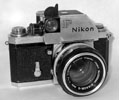 A 64 series Nikon F with most of the '64 features, including hollow wind lever, etc.,
and a Flag Photomic finder. The Flag Photomic was the first Photomic finder.
It has an external meter window, and has no on-off switch; instead, the "flag,"
visible above the meter window in this picture, blocks the light to the CdS
cell when it is lowered, reducing the current drain to near 0 and effectively
turning the meter off.
A 64 series Nikon F with most of the '64 features, including hollow wind lever, etc.,
and a Flag Photomic finder. The Flag Photomic was the first Photomic finder.
It has an external meter window, and has no on-off switch; instead, the "flag,"
visible above the meter window in this picture, blocks the light to the CdS
cell when it is lowered, reducing the current drain to near 0 and effectively
turning the meter off.
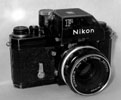 A
black 1972 Nikon F with black Photomic FTn finder. This camera has seen lots
of use, although it still works. the interesting feature of this one is seen
in the next picture--it has "US GOVT PROPERTY" engraved on the back
of the top plate. It was purchased surplus at an auction. May have belonged
to the US Navy? The lens is not original.
A
black 1972 Nikon F with black Photomic FTn finder. This camera has seen lots
of use, although it still works. the interesting feature of this one is seen
in the next picture--it has "US GOVT PROPERTY" engraved on the back
of the top plate. It was purchased surplus at an auction. May have belonged
to the US Navy? The lens is not original.
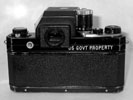
A rear view of the black '72 FTn shown above, showing the US GOVT
PROPERTY engraving.
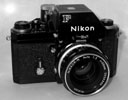 A black 1974 FTn in near-mint condition. this camera is within the last 10,000
Nikon Fs made.
A black 1974 FTn in near-mint condition. this camera is within the last 10,000
Nikon Fs made.

Nikon 64 series body with Photomic T finder. This is an averaging-reading
TTL meter that requires the user to manually set the maximum aperture of the
lens each time a lens is changed--very easy to forget. This camera also has
a later-version flash shoe mounted above the rewind knob. The 43-86 zoom is
also later than the body, since it has a rubberized focusing ring.
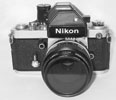 Nikon
'72 F2S. I tend to agree with the idea that the F2 is the nicest all-mechanical
35mm SLR ever made. The mechanics are so smooth that the camera is a real pleasure
to operate. It does weigh a lot, and the F2S finder eats batteries if you forget
to turn it off.
Nikon
'72 F2S. I tend to agree with the idea that the F2 is the nicest all-mechanical
35mm SLR ever made. The mechanics are so smooth that the camera is a real pleasure
to operate. It does weigh a lot, and the F2S finder eats batteries if you forget
to turn it off.
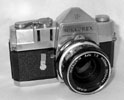
Nikkorex F. The story is that Nikon wanted to bring out a low-priced
model, following the runaway success of the F in the early 1960s. They contracted
the body out, perhaps to Mamiya. The Nikkorex F was the first camera to use
the Copal Square metal focal plane shutter that became very common later in
the 1960s and was the predecessor of many shutter designs still in use. This
camera does not have the original lens, which should be a Nikkor-S seven element
f/2, instead of the Nikkor-H. The same body was also sold as the Ricoh Singlex.
Classic camera main page
Photographic homepage
Online gallery
email me
All images and text on this site are copyrighted by Ross A.
Alford and may not be reproduced without permission
 A 64 series Nikon F with most of the '64 features, including hollow wind lever, etc.,
and a Flag Photomic finder. The Flag Photomic was the first Photomic finder.
It has an external meter window, and has no on-off switch; instead, the "flag,"
visible above the meter window in this picture, blocks the light to the CdS
cell when it is lowered, reducing the current drain to near 0 and effectively
turning the meter off.
A 64 series Nikon F with most of the '64 features, including hollow wind lever, etc.,
and a Flag Photomic finder. The Flag Photomic was the first Photomic finder.
It has an external meter window, and has no on-off switch; instead, the "flag,"
visible above the meter window in this picture, blocks the light to the CdS
cell when it is lowered, reducing the current drain to near 0 and effectively
turning the meter off.  A
black 1972 Nikon F with black Photomic FTn finder. This camera has seen lots
of use, although it still works. the interesting feature of this one is seen
in the next picture--it has "US GOVT PROPERTY" engraved on the back
of the top plate. It was purchased surplus at an auction. May have belonged
to the US Navy? The lens is not original.
A
black 1972 Nikon F with black Photomic FTn finder. This camera has seen lots
of use, although it still works. the interesting feature of this one is seen
in the next picture--it has "US GOVT PROPERTY" engraved on the back
of the top plate. It was purchased surplus at an auction. May have belonged
to the US Navy? The lens is not original.
 A black 1974 FTn in near-mint condition. this camera is within the last 10,000
Nikon Fs made.
A black 1974 FTn in near-mint condition. this camera is within the last 10,000
Nikon Fs made. 
 Nikon
'72 F2S. I tend to agree with the idea that the F2 is the nicest all-mechanical
35mm SLR ever made. The mechanics are so smooth that the camera is a real pleasure
to operate. It does weigh a lot, and the F2S finder eats batteries if you forget
to turn it off.
Nikon
'72 F2S. I tend to agree with the idea that the F2 is the nicest all-mechanical
35mm SLR ever made. The mechanics are so smooth that the camera is a real pleasure
to operate. It does weigh a lot, and the F2S finder eats batteries if you forget
to turn it off.